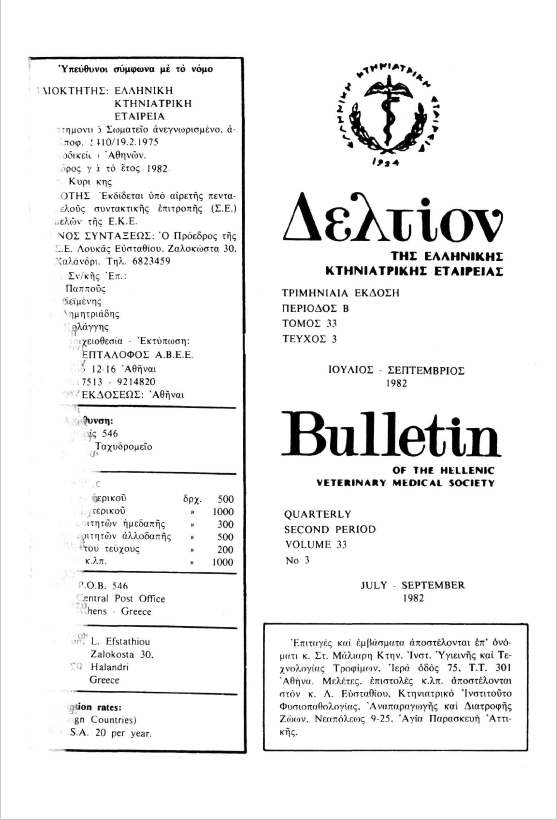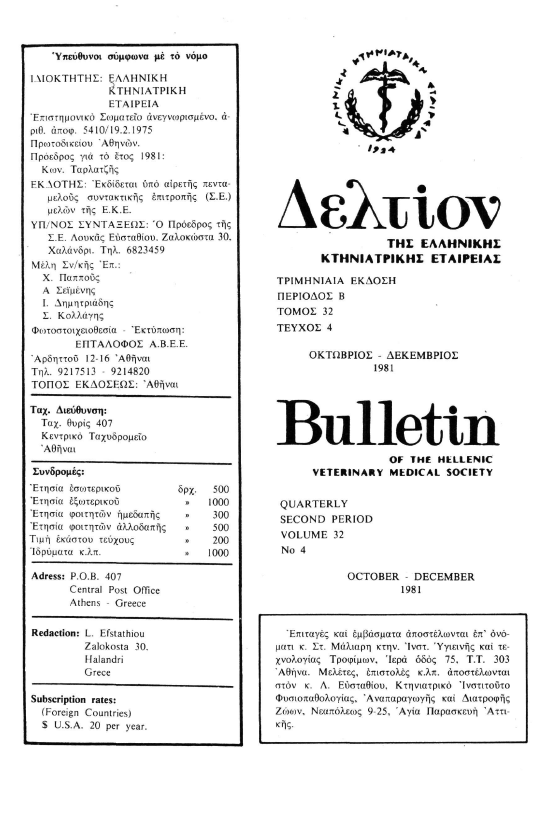Synchronization of oestrus and artificial insemination or natural mating in kids 6-7 months old
Abstract
In a herd of 92 Zaanen seminproved kids, 6-7 months old, was performed synchronisation of oestrus with sponges (Veramix Upjohn 60 mg MAP). The sponges were maintained in the kids vagina for 19 days. Two days before the withdrawal of progestagen an intramuscularly injection of 500 IU PMSG had been given to all kids. Forty kids inseminated twice with selected frozen semen, in pailletés of 0.25 ml. The first insemination took place 32 hours after the withdrwal of sponges and the second one 22 hours after the first one. In each insemination we used a pailleté contained 220-250 X 106 spçrmatozoaria. Thirty six kids of the remaining were separated in to six groups. A fertile buck was placed to each group. The groups were maintained in separated spaceous pens. After the first oestrus the kids who had been inseminated artificially incorporated with the groups of natural mating. At the second and third oestrus the matings had been done naturally. The fertility percentages at the first oestru after the withdrawal of progestagen by natural mating and artificial insemination were. 27.77% and 30% respectively. By natural mating at second and third oestrus the corresponding percentages were 46.3% and 65.5% respectively. The low fertility percentage at the first oestrus may be caused by the influence of the small age of the kids, that the number of kids who showed oestrus without ovulation was increased. Thirty four of 40 kids, a proportion of 85%, that were inseminated artificially showed intensive vaginal signals of oestrus and only 4(10%) showed light ones. Two kids showed no signals of oestrus at all. Although the fertility percentage in this age after synchronization and artificial insemination was low, it is suggested to be done because this thechnique may be acted as a trigger for the further good reproductive ability. In this herd 73,3% lambed normally and relatively early
Article Details
- How to Cite
-
ΚΑΡΑΤΖΑΣ Γ. (2019). Synchronization of oestrus and artificial insemination or natural mating in kids 6-7 months old. Journal of the Hellenic Veterinary Medical Society, 33(4), 396–403. https://doi.org/10.12681/jhvms.21564
- Issue
- Vol. 33 No. 4 (1982)
- Section
- Articles

This work is licensed under a Creative Commons Attribution-NonCommercial 4.0 International License.
Authors who publish with this journal agree to the following terms:
· Authors retain copyright and grant the journal right of first publication with the work simultaneously licensed under a Creative Commons Attribution Non-Commercial License that allows others to share the work with an acknowledgement of the work's authorship and initial publication in this journal.
· Authors are able to enter into separate, additional contractual arrangements for the non-exclusive distribution of the journal's published version of the work (e.g. post it to an institutional repository or publish it in a book), with an acknowledgement of its initial publication in this journal.
· Authors are permitted and encouraged to post their work online (preferably in institutional repositories or on their website) prior to and during the submission process, as it can lead to productive exchanges, as well as earlier and greater citation of published work.






